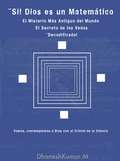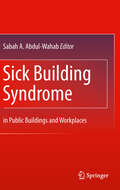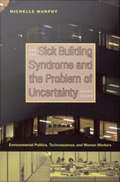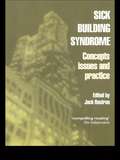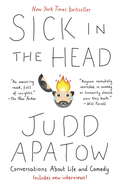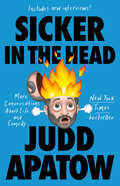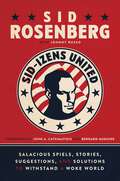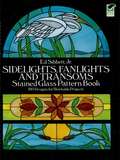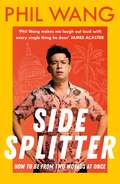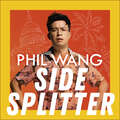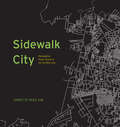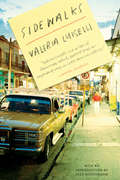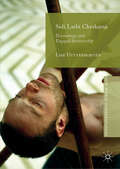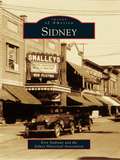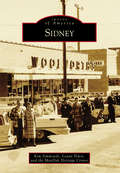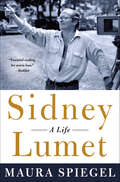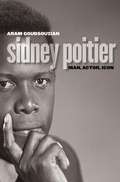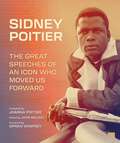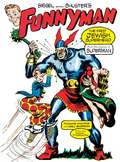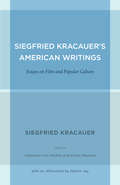- Table View
- List View
Si Dios no escuchase: Cartas a Malcolm acerca de la oración
by C. S. LewisCompuestas como una colección de envíos ficticios a su amigo Malcolm, Si Dios no escuchase: Cartas a Malcolm acerca de la oración considera esta muestra básica de devoción en su forma, contenido y regularidad, y las maneras en que refleja nuestra fe y moldea nuestra forma de creer.En esta edición de la ficticia colección de cartas de C. S. Lewis, el venerado autor reflexiona sobre la naturaleza de la oración: qué es, cómo funciona y cómo debe practicarse. La oración es un don puro, un gran regalo de Dios. Así lo entiende también Lewis. Con su brillantez habitual, el autor utiliza su correspondencia con otro intelectual para arrojar luz sobre cuestiones como:¿Cuál es el valor de la oración?¿Es la oración un soliloquio que nadie escucha?¿Qué ocurre realmente cuando oramos?¿Tiene sentido orar por los difuntos?¿Por qué es importante la liturgia?En sus argumentos, Lewis muestra una fuerte convicción y, al mismo tiempo, una gran sensibilidad y comprensión hacia las debilidades y temores del hombre. Aunque Lewis nunca pretendió que este fuera un libro de instrucciones sobre cómo orar, descubrió que el formato de correspondencia le permitía compartir sus reflexiones de forma dinámica y personal.Si Dios no escuchase: Cartas a Malcom acerca de la oración fue el último libro que terminó C. S. Lewis. Publicado póstumamente en enero de 1964, tres meses después de su muerte, es uno de los mejores libros de Lewis, aunque quizá no uno de los más conocidos. Letters To Malcom: Chiefly on PrayerComposed as a collection of fictitious dispatches to his friend, Malcolm, Letters to Malcolm: Chiefly on Prayer considers this basic display of devotion in its form, content, and regularity, and the ways it both reflects our faith and shapes how we believe.In this edition of C. S. Lewis&’s fictitious collection of letters, the revered author ruminates on the nature of prayer—what it is, how it works, and how it should be practiced. Prayer is a pure gift, a great gift from God. This is also how Lewis understands it. With his usual brilliance, the author uses his correspondence with another intellectual to shed light on questions such as:What is the value of prayer?Is prayer a soliloquy that no one listens to?What is happening when we pray?Does it make sense to pray for the deceased?Why is liturgy important?In his arguments, Lewis shows a strong conviction and, at the same time, a great sensitivity and understanding for the weaknesses and fears of man.While Lewis never intended this to be a book of instruction on how to pray, he found that the correspondence format enabled him to share his reflections in a dynamic and personal way.Letters to Malcolm: Chiefly on Prayer was the last book C. S. Lewis finished. Published posthumously in January 1964, three months after his death, it is one of Lewis&’s best books though perhaps not one of his best known.
Si, Dios es un Matematico
by Luis Rentería Ruiz Dhanesh Kumar MCreemos que Dios nunca puede ser entendido por la ciencia que exige pruebas. Desde el comienzo de los tiempos, muchos han buscado las respuestas a los misterios más grandes del mundo. Quizás el misterio más antiguo de la humanidad es "¿Cuál es la relación entre Dios y el hombre / la mujer?" Sorprendentemente, la respuesta puede estar en un modelo matemático oculto dentro de la arquitectura antigua de la India, que se cree que tiene al menos cinco mil años de antigüedad. Si puedes dedicar un par de horas a una lectura entretenida, puedes ver a Dios en el lente de la ciencia. Los devotos de todo el mundo pueden asombrarse y quizás hasta ofenderse ante la idea de que podemos buscar al Ser Divino Supremo, Dios, a través del campo rico y texturizado de las Matemáticas. Pero con un poco de paciencia, y casi sin querer, puedes aprender de una rama de las Matemáticas, entrelazada con los asombrosos mitos y leyendas de la India. Estas matemáticas no son complejas. Un alumno de secundaria puede entenderlas. Sin embargo, el producto de desarrollo es más completo que el algoritmo moderno más complejo. Para su placer de lectura, las matemáticas que respaldan este modelo se explican de una manera placentera y sin dolor, junto con una historia en el aula de clases. Cuando leemos este libro, nos sorprende ver que tales tesoros arquitectónicos son realmente los prototipos de la Divinidad. Esto demuestra cómo este modelo matemático, en esencia, se ha proyectado a sí mismo como un microcosmos del mundo real. Se imita la teoría de la Creación y Realidad como se describe en las doctrinas hindúes. Ven a disfrutar de una historia de las matemáticas, entrelazada con los asombrosos mitos y leyendas de la India. Vamos, entra en la antigua ciencia india de la Creación arquitectónica, que es un mundo lleno de curiosidades y maravillas.
Sick Building Syndrome
by Sabah A. Abdul-WahabThis volume throws light on the Sick Building Syndrome in Libraries and other public buildings, and the extent to which it is influenced by the internal environment of libraries. One of the signs of this disease is that the person suffers from a set of symptoms closely related to his/her presence in the building, without the identification of any clear causes, and his/her relief of these symptoms when he/she are out of the building. Hence, the book sheds on the extent to which the interior environment impacts upon the health of the people, and the extent to which this is reflected in their performance. The book can be used for teaching, research, and professional reference. It concludes with the recommendation that is essential to observe environmental dimensions when designing library and public buildings, taking into consideration the expected impact of SBS in library and public buildings on people. The significance of the book derives from the fact that it is the first of its kind to examine the issue of the interior environment and SBS of library and public building worldwide.
Sick Building Syndrome and the Problem of Uncertainty: Environmental Politics, Technoscience, and Women Workers
by Michelle MurphyBefore 1980, sick building syndrome did not exist. By the 1990s, it was among the most commonly investigated occupational health problems in the United States. Afflicted by headaches, rashes, and immune system disorders, office workers--mostly women--protested that their workplaces were filled with toxic hazards; yet federal investigators could detect no chemical cause. This richly detailed history tells the story of how sick building syndrome came into being: how indoor exposures to chemicals wafting from synthetic carpet, ink, adhesive, solvents, and so on became something that relatively privileged Americans worried over, felt, and ultimately sought to do something about. As Michelle Murphy shows, sick building syndrome provides a window into how environmental politics moved indoors. Sick building syndrome embodied a politics of uncertainty that continues to characterize contemporary American environmental debates. Michelle Murphy explores the production of uncertainty by juxtaposing multiple histories, each of which explains how an expert or lay tradition made chemical exposures perceptible or imperceptible, existent or nonexistent. She shows how uncertainty emerged from a complex confluence of feminist activism, office worker protests, ventilation engineering, toxicology, popular epidemiology, corporate science, and ecology. In an illuminating case study, she reflects on EPA scientists' efforts to have their headquarters recognized as a sick building. Murphy brings all of these histories together in what is not only a thorough account of an environmental health problem but also a much deeper exploration of the relationship between history, materiality, and uncertainty.
Sick Building Syndrome: Concepts, Issues and Practice
by Jack RostronSick building syndrome is for many of us an enigma. The legislative precedents currently being set in North America underline the need for rational examination of the problem. This new collection of expert writing will help unravel the complex issues involved. The book explores sick building syndrome from a range of perspectives: architectural, medical, psychological and legal. Each chapter offers detailed insights into the condition and taken together they highlight the need for a collaborative approach. The effects of sick building syndrome should not be underestimated as it is thought that up to 30 percent of refurbished buildings may suffer from the condition. Extreme cases may lead to increased absenteeism among employees, reduced performance and ultimately building closure.
Sick in the Head
by Judd ApatowFrom the writer and director of Knocked Up and the producer of Freaks and Geeks comes a collection of intimate, hilarious conversations with the biggest names in comedy from the past thirty years--including Mel Brooks, Jerry Seinfeld, Jon Stewart, Roseanne Barr, Harold Ramis, Louis C.K., Chris Rock, and Lena Dunham. Before becoming one of the most successful filmmakers in Hollywood, Judd Apatow was the original comedy nerd. At fifteen, he took a job washing dishes in a local comedy club--just so he could watch endless stand-up for free. At sixteen, he was hosting a show for his local high school radio station in Syosset, Long Island--a show that consisted of Q&As with his comedy heroes, from Garry Shandling to Jerry Seinfeld. They talked about their careers, the science of a good joke, and their dreams of future glory (turns out, Shandling was interested in having his own TV show one day and Steve Allen had already invented everything).Thirty years later, Apatow is still that same comedy nerd--and he's still interviewing funny people about why they do what they do. Sick in the Head gathers Apatow's most memorable and revealing conversations into one hilarious, wide-ranging, and incredibly candid collection that spans not only his career but his entire adult life. Here are the comedy legends who inspired and shaped him, from Mel Brooks to Steve Martin. Here are the contemporaries he grew up with in Hollywood, from Spike Jonze to Sarah Silverman. And here, finally, are the brightest stars in comedy today, many of whom Apatow has been fortunate to work with, from Seth Rogen to Amy Schumer. And along the way, something kind of magical happens: What started as a lifetime's worth of conversations about comedy becomes something else entirely. It becomes an exploration of creativity, ambition, neediness, generosity, spirituality, and the joy that comes from making people laugh.Loaded with the kind of back-of-the-club stories that comics tell one another when no one else is watching, this fascinating, personal (and borderline-obsessive) book is Judd Apatow's gift to comedy nerds everywhere.Praise for Sick in the Head "Open this book anywhere, and you're bound to find some interesting nugget from someone who has had you in stitches many, many times."--Janet Maslin, The New York Times "Incandescent . . . an irresistible, ultimate-insider's comedy-interview extravaganza . . . Apatow never loses his unabashed fan's enthusiasm even as he asks canny questions that yield superbly illuminating conversations rich in shop talk and musings on the lure, demands, and resonance of comedy."--Booklist (starred review) "If Apatow's gift for comedy is a sickness, may he never be cured."--Playboy "Sprawling and insightful . . . The candidness of the interviews also exposes the peculiar community of comedians with anecdotes and cameos unlikely to be heard elsewhere. A delightful and hilarious read for anyone interested in what makes comedians tick."--Kirkus Reviews"These are wonderful, expansive interviews--at times brutal, at times breathtaking--with artists whose wit, intelligence, gaze, and insights are all sharp enough to draw blood."--Michael Chabon "Anyone even remotely interested in comedy or humanity should own this book. It is hilarious and informative and it contains insightful interviews with the greatest comics, comedians, and comediennes of our time. My representatives assure me I will appear in a future edition."--Will FerrellFrom the Hardcover edition.
Sicker in the Head: More Conversations About Life and Comedy
by Judd ApatowAn all-new collection of honest, hilarious, and enlightening conversations with some of the most exciting names in comedy—from New York Times bestselling author and lifelong comedy nerd Judd Apatow.&“When I need to read an interview with a comedian while in the bathroom, I always turn to Judd Apatow for deeply personal insights into the comedic mind. Place one on your toilet today.&”—Amy SchumerNo one knows comedy like Judd Apatow. From interviewing the biggest comics of the day for his high school radio show to performing stand-up in L.A. dive bars with his roommate Adam Sandler, to writing and directing Knocked Up and producing Freaks and Geeks, Apatow has always lived, breathed, and dreamed comedy.In this all-new collection of interviews, the follow-up to the New York Times bestselling Sick in the Head, Apatow sits down with comedy legends such as David Letterman, Whoopi Goldberg, and Will Ferrell, as well as the writers and performers who are pushing comedy to the limits, and defining a new era of laughter: John Mulaney, Hannah Gadsby, Bowen Yang, Amber Ruffin, Pete Davidson, and others. In intimate and hilariously honest conversations, they discuss what got them into comedy, and what—despite personal and national traumas—keeps them going.Together, they talk about staying up too late to watch late-night comedy, what kind of nerds they were high school, and the right amount of delusional self-confidence one needs to &“make it&” in the industry. Like eavesdropping on lifelong friends, these pages expose the existential questions that plague even the funniest and most talented among us: Why make people laugh while the world is in crisis? What ugly, uncomfortable truths about our society—and ourselves—can comedy reveal? Along the way, these comics reminisce about those who helped them on their journey—from early success through failure and rejection, and back again—even as they look ahead to the future of comedy and Hollywood in a hyper-connected, overstimulated world.With his trademark insight, curiosity, and irrepressible sense of humor, Apatow explores the nature of creativity, professional ambition, and vulnerability in an ever-evolving cultural landscape, and how our favorite comics are able to keep us laughing along the way.
Sid-izens United: Salacious Spiels, Stories, Suggestions, and Solutions to Withstand a Woke World
by Sid RosenbergThe legendary radio personality and equal-opportunity offender delivers authentic and unapologetic takes on the state of everything—from politics to sports, and pop culture to fitness—all with his inimitable style and humor. &“Sid Rosenberg writes the way he talks: fast and blunt. His book is entertaining and provides the reader insight into a guy who hit the bottom but pulled himself up to great success. You&’ll get your money&’s worth and more.&” —Bill O&’Reilly, Media GuyPhonies and frauds, beware. Whether you&’re an athlete, entertainer, or politician—Sid Rosenberg leaves nobody unscathed. Sid helps navigate the tough topics of today, clearly laying out his thoughts and opinions in the one-of-a-kind style and charm that has made him one of the top radio and TV talents in the country. He also provides a &“call-to-action&” to the reader with his Sid-izen Solutions at the end of each hot-topic chapter. &“Every person is born with a filter between their brain and their mouth. Sid Rosenberg was born without one. Anything he thinks of he says. Love him or hate him…he&’s the real deal.&” —Chazz Palminteri A must-read for the politically incorrect, Sid-izens United: Salacious Spiels, Stories, Suggestions, and Solutions to Withstand a Woke World captures Sid at his best—showing once again why his radio show reaches millions of devoted Sid-izens each week. &“Sid Rosenberg is New York personified—caustic, unfiltered, hilarious, and with a huge heart. The bad boy of radio dispenses ripping tales about fame, sport, and politics in his new book. But the sweet bonus is the wisdom he learned from the school of hard knocks on how to succeed at marriage and fatherhood.&” —Miranda Devine &“I&’ve known Sid since he was a customer service agent for a company nobody ever heard of. The fact that I would care what he has to say about world politics or society as a whole is as shocking to me as it is to you, but here I am laughing and crying while hearing his unmistakably unique voice in my ears as I turn the pages of this book. Sid&’s a talented creator, an unapologetic and gifted performer in a sea of copycats and unoriginal thoughts. He simply stands out. We share some of the same demons and I&’m beyond proud to see him overcome them and succeed as he has and become the father and man that his dad would be so proud of. I have no idea what a Sid-izen is, and I&’m terrified now that I might be one.&” —Craig Carton
Sidelights, Fanlights and Transoms Stained Glass Pattern Book
by Ed Sibbett Jr.For well over nine centuries stained glass windows have adorned spectacular churches, important government buildings, and stately homes. It was not until relatively recently -- during the Victorian era -- that stained glass increasingly was used as an integral part of the design of middle-class, single-family residences.Traditionally, a favorite location for the placement of stained glass windows was on and around doors. Today the domestic use of stained glass windows as ornamental sidelights, fanlights, and transoms continues to be extremely popular. It is for this purpose that the fascinating stained glass patterns in this volume have been specially designed.The 180 patterns, of complexity varied enough to satisfy both the relatively inexperienced and the master crafters, represent many styles and themes: Art Nouveau, Art Deco, florals, birds, geometrics, and more. Each offers creative challenges in color design, glass cutting and construction. The patterns can be used singly or in conjunction with each other to dress up any door, or they can be adapted for many other stained glass applications. Depending on the size of the intended project, the patterns can be reproduced in larger or smaller sizes as necessary. All materials needed, including general instructions and tools for beginners, can usually be purchased from craft and hobby stores.
Sidemen: The Book
by The SidemenBillions of you have watched their videos and millions of you have followed them on social media.So here we go; it's time to back up because YouTube superstars, The Sidemen, are finally here in book form and they're dishing the dirt on each other as well as the YouTube universe. There's nowhere to hide as KSI, Miniminter, Behzinga, Zerkaa,Vikkstar123, Wroetoshaw and Tobjizzle go in hard on their living habits, their football ability, and their dodgy clobber, while also talking Fifa, Vegas and superheroes. They'll also give you their grand house tour, letting you in on a few secrets, before showing you their hall of fame, as well as revealing some of their greatest shames.Along the way you'll learn how seven of the world's biggest YouTube stars started off with nothing more than a computer console, a PC and a bad haircut before joining forces to crush the internet. And they'll tell you just how they did it (because they're nice like that) with their ultimate guide to YouTube while also sharing their memories of recording their favourite videos as well as a typical day in the life of The Sidemen.You'll feel like you're with them every step of the way, smelling the 'sweet' aroma of the boys' favourite dishes in the kitchen, stamping your passport as you follow them on their trips around the world and kicking every ball as the boys gear up for the biggest football match of their lives. It's going to get personal. It's going to get intense, and JJ is going to have lots of tantrums, so take a moment to prepare yourself, because this is The Sidemen book you've been waiting for!
Sidemen: The book you've been waiting for
by The SidemenBillions of you have watched their videos and millions of you have followed them on social media.So here we go; it's time to back up because YouTube superstars, The Sidemen, are finally here in book form and they're dishing the dirt on each other as well as the YouTube universe. There's nowhere to hide as KSI, Miniminter, Behzinga, Zerkaa,Vikkstar123, Wroetoshaw and Tobjizzle go in hard on their living habits, their football ability, and their dodgy clobber, while also talking Fifa, Vegas and superheroes. They'll also give you their grand house tour, letting you in on a few secrets, before showing you their hall of fame, as well as revealing some of their greatest shames.Along the way you'll learn how seven of the world's biggest YouTube stars started off with nothing more than a computer console, a PC and a bad haircut before joining forces to crush the internet. And they'll tell you just how they did it (because they're nice like that) with their ultimate guide to YouTube while also sharing their memories of recording their favourite videos as well as a typical day in the life of The Sidemen.You'll feel like you're with them every step of the way, smelling the 'sweet' aroma of the boys' favourite dishes in the kitchen, stamping your passport as you follow them on their trips around the world and kicking every ball as the boys gear up for the biggest football match of their lives. It's going to get personal. It's going to get intense, and JJ is going to have lots of tantrums, so take a moment to prepare yourself, because this is The Sidemen book you've been waiting for!
Sidesplitter: How To Be From Two Worlds At Once
by Phil Wang'An hilarious breath of fresh air' AMY SCHUMER'Phil Wang is as original a writer as he is a comedian. Sidesplitter is predictably hilarious but also quietly moving' SATHNAM SANGHERA'A razor-sharp dissection of cultural connections, divides and differences. And yes, it's side-splittingly funny' ADAM KAY'But where are you REALLY from?' Phil Wang has been asked this question so many times he's finally written a book about it. In this mix of comic memoir and observational essay, one of the UK's most exciting stand-up comedians reflects on his experiences as a Eurasian man in the West and in the East. Phil was born in Stoke-on-Trent, raised in Malaysia, and then came of age in Bath - 'a spa town for people who find Cheltenham too ethnic'. Phil takes an incisive look at what it means to be mixed race, as he explores the contrasts between cultures and delves into Britain and Malaysia's shared histories, bringing his trademark cynicism and wit to topics ranging from family, food, and comedy to race, empire, and colonialism.
Sidesplitter: How To Be From Two Worlds At Once
by Phil WangOne of the UK's brightest and best comedians takes an incisive look at race and belonging."But where are you really from?" Phil Wang has been asked this question so many times he's lost count. So, finally, he decided to write a book about it. About how to be from two places at once. Phil was born in the UK, in Stoke-on-Trent to an English mother and a Chinese-Malaysian father. Three weeks after his birth, the Wang family returned to his fathers' hometown in Malaysia, and at age 16, Phil was uprooted once again, to return with his family to the UK.In Sidesplitter, Phil reflects on race, belonging and cultural cachet, bringing his trademark cynicism and wit to topics that range from food and comedy to empire and colonialism.(P)2021 Hodder & Stoughton Limited
Sidesplitter: How To Be From Two Worlds At Once
by Phil Wang*A TIMES BOOK OF THE YEAR*'A hilarious breath of fresh air' AMY SCHUMER'A razor-sharp dissection of cultural differences. And yes, it's side-splittingly funny' ADAM KAY'I've laughed out loud at least once on every page' VICTORIA COREN MITCHELLPhil Wang was born in Stoke-on-Trent, raised in Malaysia, and then came of age in Bath - 'a spa town for people who find Cheltenham too ethnic'. In this brilliantly funny and incisive comic memoir he looks at what it means to be torn between two continents, bringing his trademark cynicism and wit to topics ranging from family, food and comedy to race, empire and colonialism.
Sidesplitting Jokes for Minecrafters: Ghastly Golems and Ghoulish Ghasts (Jokes For Minecrafters #4)
by Brian BooneSidesplitting Jokes for Minecrafters: Ghastly Golems and Ghoulish Ghasts is the fourth book in the Jokes for Minecrafters series, which has more than 800 belly laughs waiting for you! This laugh-a-minute book leaves no enderman or zombie unscathed, and comes complete with silly illustrations for even more fun! <p><p> For kids ages 5 and up, this book of jokes will have all your friends and family doubling over! Bust out the funniest of these Minecrafter jokes at home or school for endless jokes and fun! <p> This adventure series is created especially for readers who love the fight of good vs. evil, magical academies like Hogwarts in the Harry Potter saga, and games like Minecraft, Terraria, and Pokemon GO.
Sidewalk City: Remapping Public Space in Ho Chi Minh City
by Annette Miae KimFor most, the term public space conjures up images of large, open areas: community centers for meetings and social events; the ancient Greek agora for political debates; green parks for festivals and recreation. In many of the world s major cities, however, public spaces like these are not a part of the everyday lives of the public. Rather, business and social lives have always been conducted along main roads and sidewalks. With increasing urban growth and density, primarily from migration and immigration, rights to the sidewalk are being hotly contested among pedestrians, street vendors, property owners, tourists, and governments around the world. With"Sidewalk City," Annette Miae Kim provides the first multidisciplinary case study of sidewalks in a distinctive geographical area. She focuses on Ho Chi Minh City, Vietnam, a rapidly growing and evolving city that throughout its history, her multicultural residents have built up alternative legitimacies and norms about how the sidewalk should be used. Based on fieldwork over 15 years, Kim developed methods of spatial ethnography to overcome habitual seeing, and recorded both the spatial patterns and the social relations of how the city s vibrant sidewalk life is practiced. In "Sidewalk City," she transforms this data into an imaginative array of maps, progressing through a primer of critical cartography, to unveil new insights about the importance and potential of this quotidian public space. This richly illustrated and fascinating study of Ho Chi Minh City s sidewalks shows us that it is possible to have an aesthetic sidewalk life that is inclusive of multiple publics aspirations and livelihoods, particularly those of migrant vendors. "
Sidewalks
by Cees Nooteboom Valeria Luiselli Christina Macsweeney"Valeria Luiselli is a writer of formidable talent, destined to be an important voice in Latin American letters. Her vision and language are precise, and the power of her intellect is in evidence on every page."--Daniel Alarcón"I'm completely captivated by the beauty of the paragraphs, the elegance of the prose, the joy in the written word, and the literary sense of this author."--Enrique Vilas-MatasValeria Luiselli is an evening cyclist; a literary tourist in Venice, searching for Joseph Brodsky's tomb; an excavator of her own artifacts, unpacking from a move. In essays that are as companionable as they are ambitious, she uses the city to exercise a roving, meandering intelligence, seeking out the questions embedded in our human landscapes.Valeria Luiselli was born in Mexico City in 1983 and grew up in South Africa. Her novel and essays have been translated into many languages and her work has appeared in publications including the New York Times, Granta, and McSweeney's. Some of her recent projects include a ballet performed by the New York City Ballet in Lincoln Center; a pedestrian sound installation for the Serpentine Gallery in London; and a novella in installments for workers in a juice factory in Mexico. She lives in New York City.
Sidi Larbi Cherkaoui: Dramaturgy and Engaged Spectatorship (New World Choreographies)
by Lise UytterhoevenThis book analyses the world-renowned Belgian choreographer’s key approaches and dramaturgical strategies through selected case studies from his oeuvre between 2000 and 2010, from Rien de Rien to Babel(words). It investigates Cherkaoui’s choreographic and dramaturgic interventions in debates on the nation, culture, religion and language, by emphasising the transcultural, transreligious and geopolitical dimensions of the dialogues and exchanges he explored during this initial decade. Engaged spectatorship refers to the ongoing thinking, talking, research and writing that the spectator is invited to do in order to fulfil the work’s macro-dramaturgical potential to resist nationalism, populism and religious fundamentalism. The book meticulously explores Cherkaoui’s rich, multi-layered theatrical imagery and aural landscapes to demonstrate the agile and ever-shifting interpretive acts the works elicit from their audiences. Offering a full-length analysis of Cherkaoui’s work, the book is essential reading for students, researchers, practitioners and Cherkaoui fans.
Sidney (Images of America)
by Erin Andrews Sidney Historical AssociationNestled in the foothills of the Catskill Mountains, Sidney has hummed with economic and industrial activity since its founding by Rev. William Johnston in 1772. Over the years, the town has been home to a silk mill, glassworks, cheese factory, car factory, and many other businesses. Notable figures such as New York State Police captain Daniel Fox, actor Tom Mix, newspaper editor Arthur Bird, and even Pres. Franklin D. Roosevelt have lived in or spent time in the town. Today Sidney's civic buildings, places of worship, recreational haunts, and transportation routes continue to reflect the town's long, dynamic history. Traced within the pages of this book, a poignant collection of historical photographs chronicles the town's evolution through the 19th and 20th centuries, and on through the devastating flood of 2006.
Sidney (Images of America)
by Mondak Heritage Center Leann Pelvit Kim SimmondsPositioned just 10 miles west of the North Dakota border, and nestled against the Yellowstone River in the south, Sidney, Montana, has a rich history filled with hearty pioneers who settled in the area starting in the 1870s. Through hard work, and in both good times and bad, those pioneers managed to establish themselves and create a new culture filled with industrious, tireless homesteaders. From the Lower Yellowstone Irrigation Project, which made agriculture a viable commodity in the area, to widespread ranching, and finally to the boom-and-bust world of black gold in the Bakken, Sidney soon boasted a strong economy fueled by fertile land and hardworking people. Schools, churches, and many businesses were built, giving entrepreneurs the opportunity to prosper in the region. Featured here in over 200 vintage photographs is the history of this pioneer town, once boasted as the "Metropolis of the Lower Yellowstone Valley."
Sidney Lumet: A Life
by Maura SpiegelThe first-ever biography of the seminal American director whose remarkable life traces a line through American entertainment historyAcclaimed as the ultimate New York movie director, Sidney Lumet began his astonishing five-decades-long directing career with the now classic 12 Angry Men, followed by such landmark films as Serpico, Dog Day Afternoon, and Network. His remarkably varied output included award-winning adaptations of plays by Anton Chekhov, Arthur Miller, Tennessee Williams, and Eugene O’Neill, whose Long Day’s Journey into Night featured Katharine Hepburn and Ralph Richardson in their most devastating performances. Renowned as an “actor’s director,” Lumet attracted an unmatched roster of stars, among them: Henry Fonda, Sophia Loren, Marlon Brando, Anna Magnani, Sean Connery, Ingrid Bergman, Paul Newman, Al Pacino, Ethan Hawke, and Philip-Seymour Hoffman, accruing eighteen Oscar nods for his actors along the way. With the help of exclusive interviews with family, colleagues, and friends, author Maura Spiegel provides a vibrant portrait of the life and work of this extraordinary director whose influence is felt through generations, and takes us inside the Federal Theater, the Group Theatre, the Actors Studio, and the early “golden age” of television. From his surprising personal life, with four marriages to remarkable women—all of whom opened their living rooms to Lumet’s world of artists and performers like Marilyn Monroe and Michael Jackson—to the world of Yiddish theater and Broadway spectacles, Sidney Lumet: A Life is a book that anyone interested in American film of the twentieth century will not want to miss.
Sidney Poitier
by Aram GoudsouzianIn the first full biography of actor Sidney Poitier, Aram Goudsouzian analyzes the life and career of a Hollywood legend, from his childhood in the Bahamas to his 2002 Oscar for lifetime achievement. Poitier is a gifted actor, a great American success story, an intriguing personality, and a political symbol; his life and career illuminate America's racial history. In such films as Lilies of the Field, In the Heat of the Night, and Guess Who's Coming to Dinner, Poitier's middle-class, mannered, virtuous screen persona contradicted prevailing film stereotypes of blacks as half-wits, comic servants, or oversexed threats. His screen image and public support of nonviolent integration assuaged the fears of a broad political center, and by 1968, Poitier was voted America's favorite movie star.Through careful readings of every Poitier film, Goudsouzian shows that Poitier's characters often made sacrifices for the good of whites and rarely displayed sexuality. As the only black leading man during the civil rights era, Poitier chose roles and public positions that negotiated the struggle for dignity. By 1970, times had changed and Poitier was the target of a backlash from film critics and black radicals, as the new heroes of "blaxploitation" movies reversed the Poitier model. In the 1970s, Poitier shifted his considerable talents toward directing, starring in, and producing popular movies that employed many African Americans, both on and off screen. After a long hiatus, he returned to starring roles in the late 1980s. More recently, the film industry has reappraised his career, and Poitier has received numerous honors recognizing his multi-faceted work for black equality in Hollywood. As this biography affirms, Poitier remains one of American popular culture's foremost symbols of the possibilities for and limits of racial equality.
Sidney Poitier: The Great Speeches of an Icon Who Moved Us Forward
by Sidney Poitier Joanna PoitierThe speeches of film legend Sidney Poitier—given at commencement addresses, awards shows, memorials, and more, on topics ranging from entertainment history to filmmaking, civil rights, and parenthood—come to vibrant life in this inspirational and stunningly packaged volume from the Poitier estate that sheds new light on the trailblazing artist's life and culture of the past century. Sidney Poitier represented strength, good looks, and above all dignity at a time when Black representation on the screen was so often relegated to servile parts. He broke ground as the top box-office draw in Hollywood at the peak of his career, and was the first Black actor to win the Best Actor Oscar, for his performance in Lillies of the Field (1963). Poitier—who narrowly escaped illiteracy after rising up from an impoverished childhood and the massive obstacles he faced as a Black man in mid-twentieth century America—was also one of the most articulate and sought-after speakers of his day. This book is a one-of-a-kind collection showcasing the wise, witty, and deeply personal speeches Poitier gave at awards ceremonies, family events, memorials, and more. His salutes to artists such as Dorothy Dandridge, Spencer Tracy, Stanley Kramer, and Denzel Washington offer fresh insight on icons of our time. Poitier's unforgettable cadence and voice are clear as day on the page, sometimes with careful edits and additions written in his own hand. Compiled by his wife, Joanna Poitier, and illustrated by dozens of professional and family photos, this collection stunningly captures all that was remarkable about the man through his own words; archives moments in the history of entertainment, culture, and civil rights; and offers a uniquely inspirational perspective on career, family, art, and life.
Siegel and Shuster's Funnyman
by Jerry Siegel Joe Shuster Thomas Andrae Mel GordonHere is a kaleidoscopic analysis of Jewish humor as seen through Funnyman, a little-known super-heroic invention by the creators of Superman. Included are complete comic-book stories and daily and Sunday newspaper panels from Jerry Siegel and Joe Shuster's creative fiasco.Siegel and Shuster, two Jewish teenagers from Cleveland, sold the rights to their amazing and astonishingly lucrative comic book superhero to Detective Comics for $130 in 1938. Not only did they lose the ownership of the Superman character, they also agreed to write and illustrate it for ten years at ten dollars per page. Their contract with the DC publishers was soon heralded as the most foolish agreement in the history of American popular culture.After toiling on workman's wages for a decade, Siegel and Shuster struggled to come up with a new superhero, one that would right their wrongs and prove that justice, fair-play, and zany craftsmanship was the true American way and would lead to ultimate victory. But when the naïve duo launched their new comic character Funnyman in 1947, it failed miserably. All the turmoil and personal disasters in Siegel and Shuster's postwar life percolated into the comic strip.This book tells the back story of the unsuccessful strip and Siegel and Shuster's ambition to have their funny Jewish superhero trump Superman.Mel Gordon is the author of Voluptuous Panic: The Erotic World of Weimar Berlin.Thomas Andrae is the author of Batman and Me.
Siegfried Kracauer's American Writings
by Martin Jay Johannes Von Moltke Siegfried Kracauer Kristy RawsonSiegfried Kracauer (1889-1966), friend and colleague of Walter Benjamin and Theodor Adorno, was one of the most influential film critics of the mid-twentieth century. In this book, Johannes von Moltke and Kristy Rawson have, for the first time assembled essays in cultural criticism, film, literature, and media theory that Kracauer wrote during the quarter century he spent in America after fleeing Nazi-occupied Europe. In the decades following his arrival in the United States, Kracauer commented on developments in American and European cinema, wrote on film noir and neorealism, examined unsettling political trends in mainstream cinema, and reviewed the contemporary experiments of avant-garde filmmakers. As a cultural critic, he also ranged far beyond cinema, intervening in debates regarding Jewish culture, unraveling national and racial stereotypes, and reflecting on the state of arts and humanities in the 1950s. These essays, together with the editors' introductions and an afterward by Martin Jay offer illuminating insights into the films and culture of the postwar years and provide a unique perspective on this eminent émigré intellectual.

